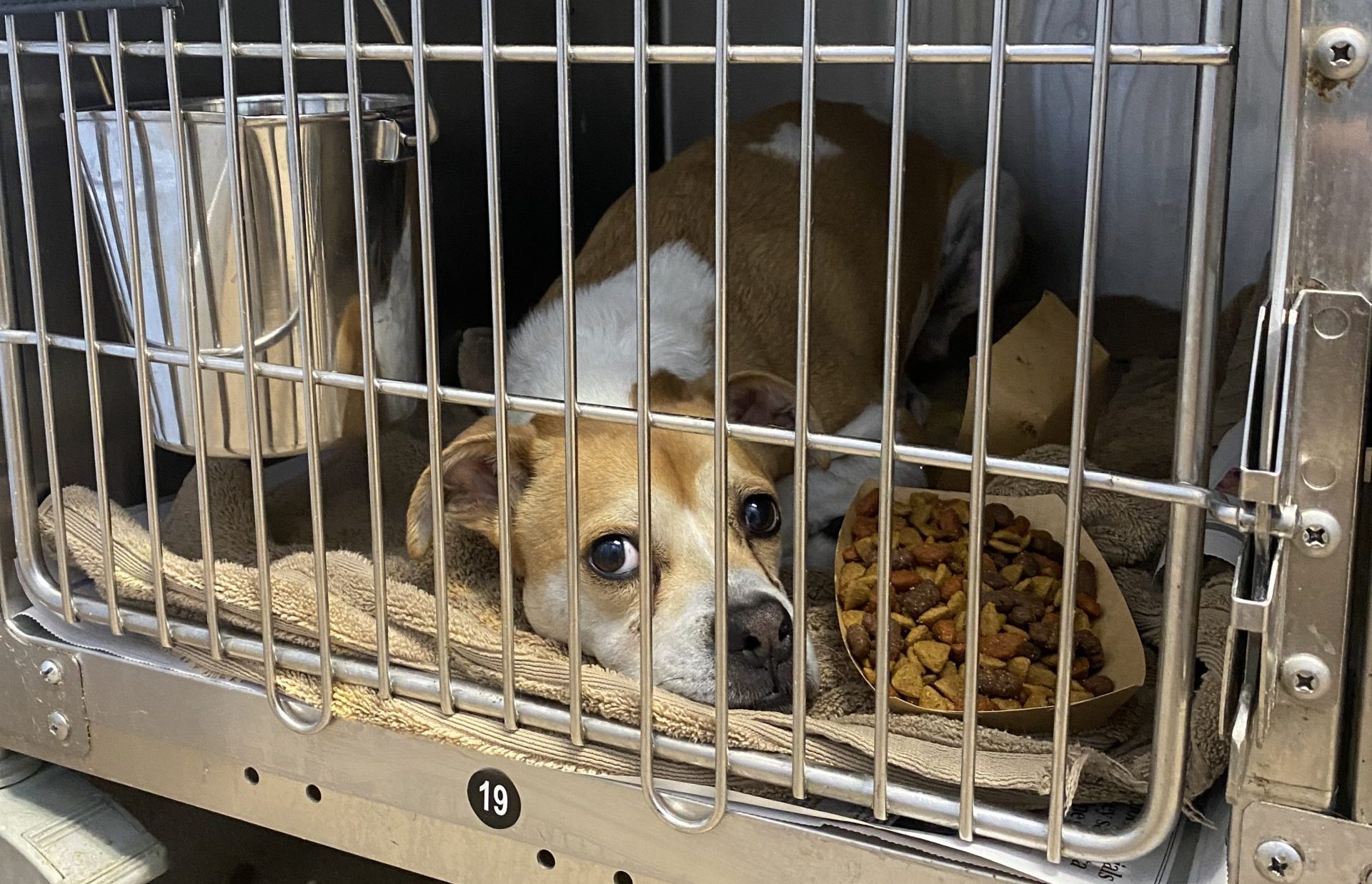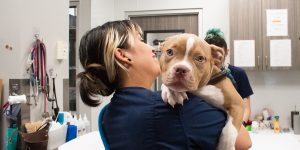Recent media coverage has called out LifeLine’s “no-kill” philosophy as the culprit in this ongoing crisis, despite the fact that shelters across the country are experiencing the same challenges. We’d like to take a moment to explain what no-kill is, and what it means to us.
Over the last decade, “no-kill” has generally been defined as meeting or surpassing a 90% lifesaving rate. In other words, a shelter is considered a no-kill if 90% of the animals entering the shelter leave the shelter alive. However, if you were to type this phrase into a search engine online, it would be hard to find a concrete definition. Operationally, no-kill means saving all healthy and treatable animals and reserving euthanasia only for animals who are medically untreatable or behaviorally unsafe with little chance of rehabilitation. The 90% lifesaving rate is an average established by the industry. Some shelters may achieve even higher save rates, particularly shelters, like the Atlanta Humane Society, PAWS Atlanta, and FurKids, which are able to limit the number, type, medical condition, and temperament of the animals brought into their shelters. These shelters are called “limited admission” shelters. LifeLine once was such a shelter, but over a decade ago, we made the decision that it was more important to make Atlanta a no-kill community – where all healthy or treatable animals are saved – rather than maintain no-kill status as an organization by limiting the number and type of animals coming through our doors. We concluded that, for LifeLine, which has always sought to end the shelter euthanasia of healthy and treatable animals, “no-kill” was a hollow designation when the county shelter around the corner was euthanizing 50% or more of the animals coming into its care.
Unlike the limited-admission shelters, municipal shelters – those operated by city or county governments – are considered open-admission shelters. All animals needing shelter, including lost or stray animals, injured animals, abandoned animals, animals without homes when their families are evicted, animals whose owners cannot care for or no longer want, and animals seized by law enforcement in cruelty or neglect cases or when their owners are arrested for other crimes, all come into the open-admission county shelters, regardless of their type, temperament, health, or the shelter’s capacity. LifeLine contracts with Fulton and DeKalb County to operate the open-admission county shelters. From the beginning of the modern American humane movement in 1866 until 2001, all open-admission municipal shelters in the United States euthanized animals to keep the number of animals in the shelter below, and sometimes well below, the shelter’s capacity. This practice, utilizing euthanasia to keep a shelter below its capacity – is what is known as “euthanizing for space.”
Until the advent of widespread spaying and neutering of pets, and particularly the development of low-cost, high-volume spay/neuter practices, euthanasia for space was unavoidable. The number of animals entering open-admission shelters was massive, exponentially higher than the number today, even in our current crisis. Shelter euthanasia for population control necessarily was the norm, and in most county shelters, it was routine. Animals were held for the amount of time legally required – usually 3 to 5 days – and then euthanized. Some shelters, like the Fulton County shelter LifeLine now operates, were closed to the public, and the majority of the animal population was never given even the opportunity for new homes. When LifeLine was founded in 2002, 85% of the animals entering the Fulton and DeKalb County shelters were euthanized.
From its inception, the term “no-kill” has been controversial and divisive. People who worked in shelters when euthanasia for population control was necessary, some of whom work for LifeLine today, loved animals and always wanted what was best for them. Over time, the industry had more than come to terms with the necessity of euthanasia, and the idea that it was anything other than humane was intolerable. On its face, the term no-kill represented a shift in industry vernacular that characterized a practice, once widely considered humane, as “killing,” and thus, wrong. The animal welfare field has never recovered from this divide.

In the last 20 years, municipal shelters across the country began implementing lifesaving programs – robust adoption and marketing efforts, expansive foster home networks, partnerships with local limited-admission shelters and rescue groups, community cat trap-neuter-return initiatives, and subsidized high-volume spay/neuter – all toward making euthanasia for space a thing of the past. Indeed, LifeLine is an industry leader in developing these programs in our county shelters. Most every national organization, including the ASPCA, the Humane Society of the United States, and Best Friends Animal Society, embrace the no-kill philosophy, even if they do not embrace the term no-kill. Only one national organization, PETA, consistently opposes no-kill. PETA’s entire argument, however, is not simply that no-kill leads to overcrowding and consequent suffering, rather PETA maintains that pet ownership itself is the source of the animals’ suffering:
We at PETA very much love the animal companions who share our homes, but we believe that it would have been in the animals' best interests if the institution of "pet keeping"—i.e., breeding animals to be kept and regarded as "pets"—never existed. The international pastime of domesticating animals has created an overpopulation crisis; as a result, millions of unwanted animals are destroyed every year as "surplus." This selfish desire to possess animals and receive love from them causes immeasurable suffering, which results from manipulating their breeding, selling or giving them away casually, and depriving them of the opportunity to engage in their natural behavior. Their lives are restricted to human homes where they must obey commands and can only eat, drink, and even urinate when humans allow them to."
- Animal Rights Uncompromised: PETA on Pets: published on PETA's website, January 8, 2007
Nonetheless, the paradigm shift envisioned by no-kill advocates, where healthy and treatable animals are not euthanized in shelters, has garnered wide acceptance and support. By 2020, a no-kill nation appeared well within reach. And then came the pandemic, and now, the aftermath.
To be sure, no-kill has never been easy. At LifeLine, we have always been committed to the difficult journey to save lives. “No-Kill” isn’t a policy that prohibits euthanasia under any circumstances, rather, it is an operational philosophy centered on lifesaving programs, and rejects the practice of euthanasia as “humane” population control. The strategy is to give each individual animal the second chance to find a home that they deserve – to save every healthy or treatable animal who can be saved. Every animal comes into our care as the result of some human failure, and at LifeLine, we believe that as an organization and as humans, we owe them their lives. Our mission is to end the shelter euthanasia of healthy and treatable animals, in other words, to eradicate the use of euthanasia as a means of shelter population control. We have succeeded in not using euthanasia for population control in the past, but not always, and not now.
When LifeLine Animal Project took over the contracts to manage the Fulton and DeKalb County animal services facilities in 2013, the lifesaving rates for animals coming into the shelters were 39% and 61%, respectively. It took 7 years for LifeLine to increase lifesaving rates above 90% in both counties. We invested in lifesaving programs and teams and have built a strong foundation. Because of present circumstances, including high intake, more animals at large, economic turmoil, low adoption rates, reduced rescue partner capacity, limited affordable options for spay/neuter and pet care, and limited affordable, pet-friendly housing, the lifesaving rates for the Fulton and DeKalb County shelters currently are 86.4% and 84.7%, respectively.*
While, tragically, we are running out of life-saving options for the animals in our care, absent a substantial outpouring of adopters and fosters from our community, we are not giving up. We’ve done it before, and with the help of a caring community, we will do it again. We don’t believe we can kill our way to a solution, even if we do not have the space or resources today to save all who can and should be saved. We are developing new programs with our county partners to intervene before pets are at risk of coming to the shelter. We will continue to provide affordable access to spay/neuter and wellness care, offering free support, resources, and information to pet owners in need. We are restructuring foster teams to better support a legion of foster caregivers. We are raising money to compete for veterinary professionals in an ever-tightening market. We are raising funds to give our shelter animals a better chance, through advertising and outreach, to compete with a growing internet market and public demand for “designer” breeds and purebred pets, to make lifesaving trendsetting.
As an organization, we have publicly and proudly celebrated meeting and sustaining the no-kill threshold in our county shelters. But, with the unrelenting flow of animals into the shelter this year and the decrease in adoptions and transfers, we have not been able to do so. We understand the community’s confusion and critical lens aimed at how our city’s shelters are being managed. Let us be clear: LifeLine’s commitment to no-kill – to saving every healthy and treatable animal who comes into our shelters – is unwavering. While DeKalb County may be reconsidering its no-kill resolution, passed in 2017, the Fulton County government has no such resolution. Regardless, our county contracts over the last decade have never required nor fully compensated us for saving lives. Lifesaving is our commitment to the animals and to you, and we aren’t rethinking it.
*This figure is for the month of September 2023.





